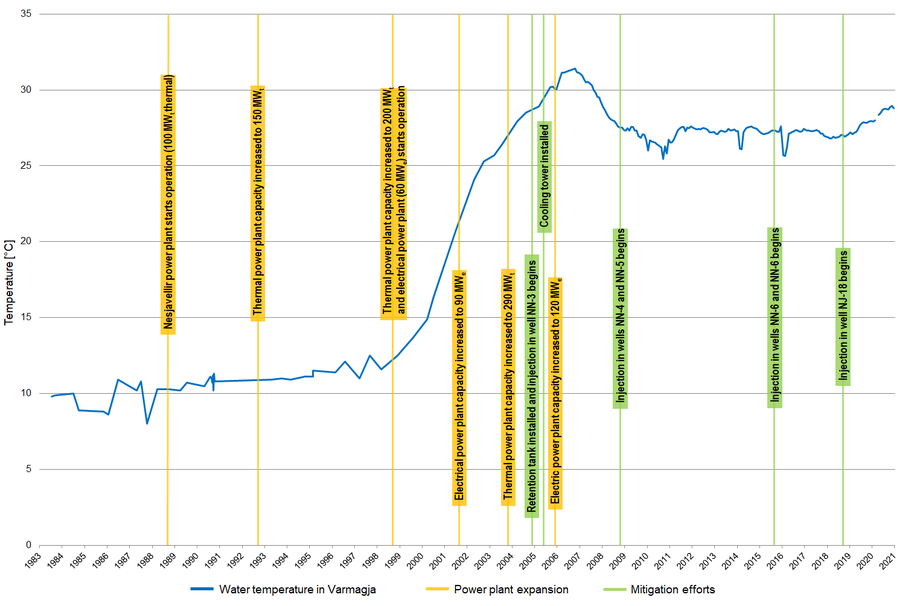Discharge of geothermal fluids
Geothermal fluid is reinjected into the geothermal system at Hellisheidi and Nesjavellir Geothermal Power Plants, to protect surface and groundwater, as the geothermal fluid is warmer than groundwater and has a different chemical composition. The aim is also to increase the pressure in the geothermal reservoir, which in turn boosts sustainable utilisation.
Various research and development projects have been conducted in recent years to fulfil reinjection requirements at Hellisheidi and Nesjavellir, with considerable success.
Hellisheidi Geothermal Power Plant
In 2020, 69.3% of geothermal fluid extracted from the geothermal reservoir at Hellisheidi (separated water and condensate water) was reinjected, 99.9% of which was separated water. The condensate water (dense, pure steam) not used for reinjection (30.6% of the geothermal fluid), evaporated in the cooling towers or was released in shallow reinjection wells. Some 0.1% of the geothermal fluid went into the overflow of the reinjection utility, due to either procedure or incidents in operations.
Nesjavellir Geothermal Power Plant
In 2020, over 70% of the geothermal fluid extracted from the geothermal reservoir was reinjected into the system, thereof approximately 10% into the geothermal reservoir. The development of the reinjection utility at the plant in recent years, has resulted in the discharge of geothermal fluid being at an all time low over the past three years.
Despite the great success of the reinjection system at the Nesjavellir Geothermal Power Plant, energy production is nevertheless accompanied by substantial discharge of heated groundwater at the surface. Groundwater has been extensively monitored in the past by recording boreholes and hot spring temperatures in real-time, and samples have also been collected since the power plant began its operations in 1990. The results do not show a decrease in groundwater temperatures, despite less discharge. The reasons behind these findings are not clear, but could be attributed to the following:
- The reinjection of geothermal fluid does not result in cooling of the groundwater because the reinjected fluid mixes with the groundwater, following flow paths underground in the bedrock.
- Improvements, made to the release routes, have not yet resulted in cooling of the groundwater in the lake Þingvallavatn.
Increased supply of geothermal water to the capital area
The capital area, except for Kjalarnes and rural Mosfellsdalur, was supplied with hot water from geothermal power plants for up to three months, during the summer of 2020. Going forward, the aim is to decrease production from low-temperature geothermal fields during the summertime, in order to further utilise the energy that is produced in power plants.
Impact on the ecosystem
Monitoring the ecosystem in the bay Þorsteinsvík, in the lake Þingvallavatn, began before the Nesjavellir Geothermal Power Plant was built. The results of measurements, made by the Natural History Museum of Kópavogur, show that trace elements from geothermal water, previously considered to have a negative impact on the ecosystem, do not show a statistically significant increase.
Analysis of the status of groundwater at Nesjavellir will continue, in order for ON Power to achieve its objective of reducing the environmental impact of the Nesjavellir Geothermal Power Plant.

Water temperature at Varmagjá at Þingvallavatn, the development of the Nesjavellir Geothermal Power Plant and mitigation measures
Induced Seismic Activity
In 2020, an earthquake of magnitude 3.6 hit ON Power's reinjection area. It was felt widely, but did not cause any damage. Therefore, Reykjavik Energy Group did not meet its objective to safeguard that seismic activity, potentially associated with the reinjection of geothermal fluid, would not cause an inconvenience. However, its objective to not cause damage, was met.
The reinjection of geothermal fluid can cause seismic activity, known as induced seismic activity, or triggered earthquakes, especially at the Húsmúli area. Blasting, associated with geological research and drilling in high-temperature fields, may also be the culprit. ON Power follows procedures, that are designed to minimise the risk of triggered earthquakes at and around the Hengill area.
Two earthquakes over the magnitude of 3.0 struck the area in 2020. An earthquake of magnitude 3.7 was recorded roughly 4 km north-west of the Hellisheidi Geothermal Power Plant in February 2020. The tremors were widely felt. No changes in reinjections procedures had been implemented before this earthquake occurred. In November 2020, an earthquake of magnitude 3.3 was registered below the reinjection area at Húsmúli, and this was the largest earthquake that had hit the area since September 2016. The earthquake was felt in Hveragerði, Eyrarbakki, Selfoss, and in some parts of the capital area. Due to the location of the earthquake, and the fact that no changes had been implemented during the process of reinjection of geothermal water prior to its occurrence, it is believed that it was caused by release of tension in the bedrock, which prolonged production and reinjection may cause. A notification was sent to licencing authorities, other stakeholders and the media.
In 2020, no notifications were sent to the Icelandic Meteorological Office's seismic activity division, or the Department of Civil Protection and Emergency Management of the Icelandic Police, due to changes in the process of reinjection.
Appendices and links
- Seismic activity web page of the Icelandic Meteorological Office
- Monitoring of trace elements in Þingvallavatn due to the Nesjavellir Geothermal Power Plant (IS)
- Release of geothermal water from the Nesjavellir and Hellisheidi geothermal power plants. Groundwater monitoring (PDF)
- Research and development projects to meet injection demands at Hellisheidi and Nesjavellir (PDF)
- Development of seismic activity at the Hellisheidi Geothermal Power Plant since the autumn of 2011 (PDF)
